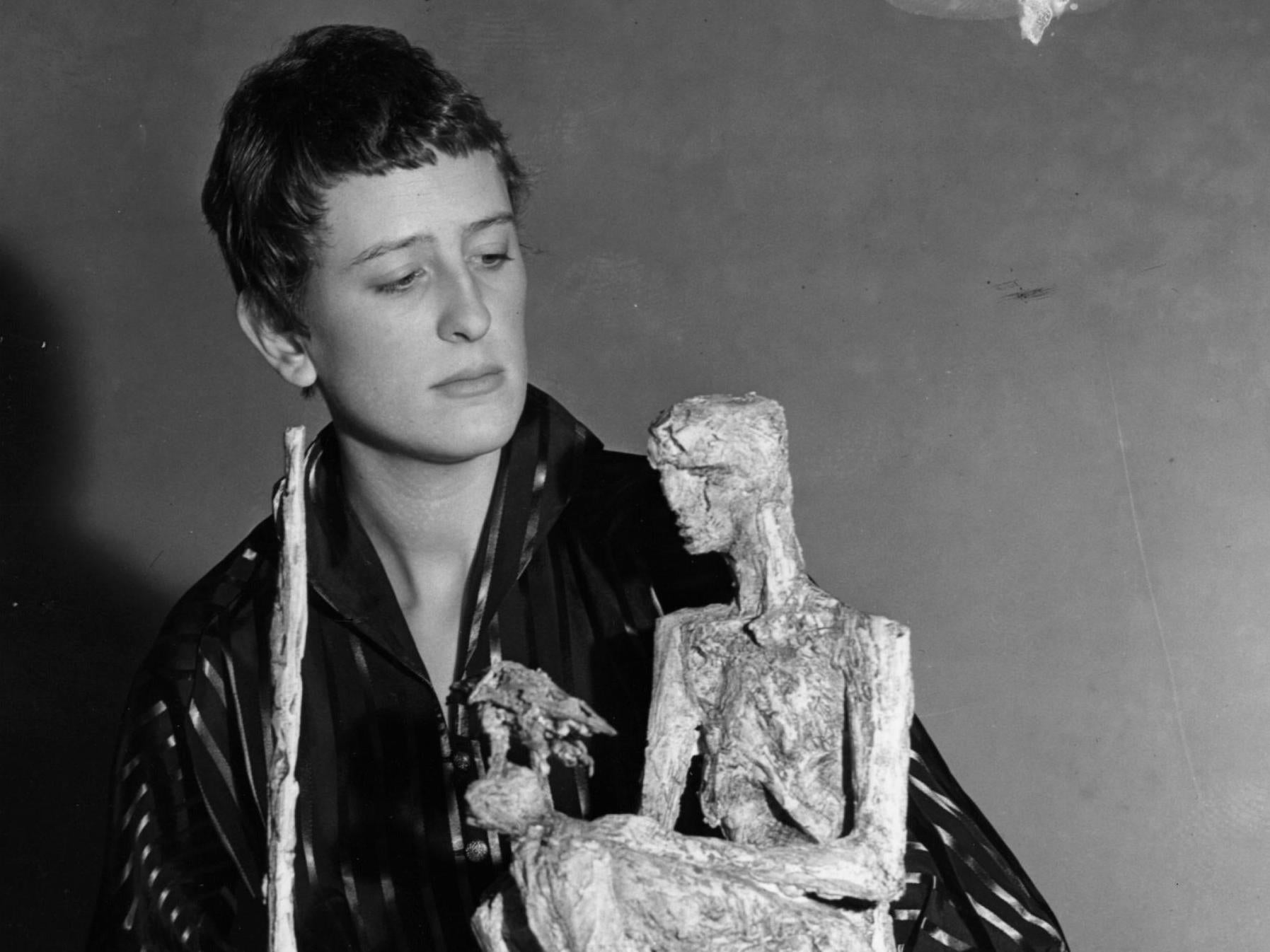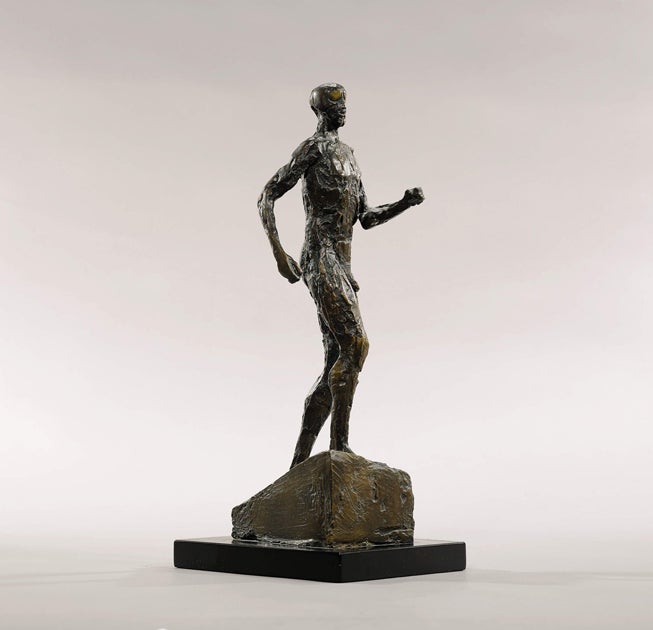A Life in Focus: Dame Elisabeth Frink, sculptor
The Independent revisits the life of a notable figure. This week: Elisabeth Frink, from Monday 19 April 1993

Elisabeth Frink was a woman of great courage, integrity and style who gambled continuously against the odds, both in her work – against stylistic fashion or any kind of comfortable or ingratiating image – and in her life. She achieved the extraordinary distinction of becoming, without any compromise, a genuinely popular sculptor whose work is admired by a broad public in Britain and abroad. Her dogs and horses have their own authenticity, but the images of a single naked male figure, standing, walking or running, say something about endurance, vulnerability and essential human nature that haunts the memory.
Frink came to maturity as a young sculptor in the mid-Fifties, encouraged from the very outset of her professional career by the attentive if not always respectful climate of support established for British sculpture internationally by Henry Moore. Before the Second World War, the only sculptures broadly visible to the general public in England were war memorials, equestrian statues or the occasional commemorative municipal plaque. Artists like Jacob Epstein, Moore, Barbara Hepworth, Maurice Lambert, Frank Dobson and Leon Underwood were confined to very small dealers’ galleries, a tiny public and the odd leaden spoof among the cartoons in Punch.
The resilient theme of Moore’s wartime Family Group series of bronzes and the harrowing topicality of his drawings, commissioned by Kenneth Clark for the War Artists’ records, of Tube shelterers made during the air raids, changed the British public’s perception of how a sculptor could actually touch a national nerve. The successful arrival in the immediate post-war years of other prize-winning sculptors – Bernard Meadows, Kenneth Armitage, Lynn Chadwick, Reg Butler, Geoffrey Clarke among them, all about a decade older than Frink – confirmed the comparatively positive climate in which the young Frink found herself.
If Frink’s professional context with its fresh opportunities came from Moore’s wartime example and success, her imaginative world was also quite radically affected, if not fully formed, by the war. Her father was at Dunkirk as a professional soldier, and saw much action elsewhere; the family at home lived near an airfield in Suffolk where bombers often returned to base in flames. As a very young schoolgirl, Frink had to hide in the hedges from the machine-gun attack of a German fighter plane. As a 15-year-old schoolgirl, she watched on her local cinema screen the first appalling news pictures of Belsen. Her earliest drawings, even before she went to Chelsea School of Art in 1949, were powerful but grim in tone: wounded birds, apocalyptic horses and riders, falling men.
Life in England was still harsh for at least a decade after the war, with the continuance of wartime rationing and the day-to-day reality, often lowering to the spirit, of an impoverished austerity. But the sombre mood of the times, still bleak in the aftermath of Hiroshima and Nagasaki, was all the same fortified by the hopes aroused through the formation of the United Nations Organisation and sheer relief at the cessation of hostilities. In the world of art, architecture and design there was even an expansive feeling of optimism which culminated in the celebratory 1951 Festival of Britain. There seemed to be a real opportunity for good young architects to repair cities devastated by bombing with new architecture. The Royal Festival Hall appeared on the South Bank.
Those who worked in the art world were encouraged by the greatly expanded public for art created through the wartime efforts of Cema, the Council for the Encouragement of Music and the Arts, formed by Maynard Keynes, Kenneth Clark and others, the embryo of our post-war Arts Council. At Cema, there was the startling discovery in the early years of the war that in many parts of the country quite large numbers of people had never seen an original work of art of any kind in their lives, a discovery which gave a real driving edge to the task of travelling exhibitions. Patricia Strauss, the wife of George Russell Strauss MP – who tried to persuade the government to use half of 1 per cent of the cost of all new buildings for works of art – pioneered the first international sculpture exhibition in Battersea Park.
A good measure of all this hope and idealism is reflected in Elisabeth Frink’s sculpture as an extension of her own stoic and idealistic nature. Growing up in the country, close to animals and birds, Frink’s sculptures of living creatures are by no means gloomy or painful. The early wounded birds, which preceded the images of men attempting to fly and helmeted and goggled airmen, soon gave place to idealised winged figures. Frink’s great bronze horses became famous, ranging from standing or prancing horses to the memorable Rolling Horse of 1982; her sculptures of dogs, quizzical and alert, all seem equally forceful, convincing and unsentimental.

But, on certain occasions, Frink did not see animals only on their own terms. A recent, larger than life-sized bronze sculpture of a War Horse, huge, powerful and muscular as it is, still presents us with our culpability. As Frink said, “They carried men into battle.” Also recently, a sequence of sculptures of baboons, in isolation, have great poignancy through their closeness to man. A recent project to sculpt on a large scale a seated man looking up at a crouching baboon which stares into space was not fulfilled. Neither was Frink’s intention to find the right approach, sculpturally, to project on an equally large scale her image of the Green Man, an ancient symbol of regeneration and the fertility of spring, with branches sprouting from the head of a male figure.
After Frink’s early, quiet but very real success in the Fifties, her most testing time came in the Sixties and Seventies. An “academic” work of art, in the pejorative sense of the word, merely leans on tradition or feeds upon convention without energising or expanding that tradition. As figurative imagery, Frink’s sculptures always avoided the negatively “academic” label through their extreme individuality of mood, given life through a highly personal approach to form. Frink consistently carved the wet plaster after rough preliminary modelling, creating a particular surface tension and concentration of form, and this remained her only debt to Moore – for there are no stylistic similarities. Her personal lodestar, if she had one, was always Alberto Giacometti. But in the Sixties, the “new generation” of sculptors in England, following Anthony Caro’s precepts, abandoned both modelling and carving in favour of assemblage, the art of creating form by the additive process – as opposed to the reductive process of carving or modelling – of putting together disparate elements, steel sheets or bars or found component parts from factories or steelyard waste. Brilliant colour and transparent materials were also involved and, although the new sculpture had its own variable mood, it was entirely abstract.
To some, Frink’s sculpture looked increasingly old-fashioned rather than academic, with its recognisable imagery and insistence on the traditional substance and properties of bronze. But Frink continued to explore her expanding vision, ignored the strong pressures of fashion and proceeded to make her strongest and most characteristic work. Her public grew, together with critical recognition.
Frink’s earliest male figures are not so much tentative as distorted by effort or blurred by action. Gradually, through the later Sixties and Seventies, came a series of slightly larger than life-sized figures: walking, running, standing, in action or in contemplation, and these male figures, lean, bony, pared down to essential form but richly if tersely expressive, have some quality of timelessness and endurance which will remain Frink’s unique contribution to sculpture, culminating in the weightier, more aggressive and harshly coloured warrior figures of recent years, inspired indirectly by the ancient Greek Riace bronze figures – larger than life-sized bronzes rescued from the sea by archaeologists off southern Italy. Affected by the discovery of Aboriginal art on a visit to Australia, Frink applied some startling colour-effects to these baleful figures which completely subdue in lurid presence their ancient Greek prototypes.
Among this long-drawn-out, varied and wholly unfashionable sequence of male figures, Frink made two very grand groups of monumental male heads. At the time of the Algerian war, Frink saw a photograph of a man called Oufkir who was held responsible for the death of the Algerian freedom fighter Ben Barka. The blank, thuggish face, given a sinister edge by impenetrable black spectacles, haunted Frink and her first goggle-head appeared.
Then, in 1975, she made a monumental group of four male heads, with closed eyes and clearly modelled, serene features. These were the Tribute Heads, referring to people who had died for their beliefs. “In a sense, these sculptures are a tribute to Amnesty International,” the sculptor said. “The heads represent the inhumanity of man – they are the heads of victims.” A more recent pair of monumental heads is called In Memoriam, with eyes open, and are an extension of the same theme: people who have been tortured for their beliefs.
Elisabeth Frink’s strong feeling for the wretched suffering that seems so persistent in the modern world was extremely dry and unsloppy. She was wholly unsentimental as an artist, and her manner and way of talking was laconic, impulsive, full of humour, but also very decisive and rigorously practical. Privately, she was endlessly generous to good causes.
She grew up as a practising Catholic and a few of her commissions, honourably fulfilled, were for churches, although it is the secular work on public display that comes more swiftly to mind, like Horse and Rider in Dover Street, London, Dorset Martyrs in Dorchester, or Paternoster, the Shepherd with Three Lambs group for Paternoster Square. She made some very strong illustrations for Chaucer and Homer and some fine portrait busts, notably of Alec Guinness and John Pope-Hennessy. Her many studies of birds and animals are perhaps the most beautiful drawings of these subjects made since Henri Gaudier-Brzeska’s death. Frink’s sense of the world and its wonders as well as its horrors was perhaps broader and deeper than any specific religion could satisfy.
A handsome woman with great spirit and presence, Elisabeth Frink was married three times: first in 1955 to Michel Jammet, whose family owned an old-established and celebrated restaurant in Dublin. Their son, Lin, a painter, was born in 1958. In 1964, Frink married Edward Pool, a distinguished war hero, and settled with him in France, in the country near the Camargue where she lived and worked until the mid-Seventies. In 1974, Frink married Alexander Csaky and settled in Dorset in an old country house with space for studies and unpretentious but spacious grounds which her sculptures inhabited as vigorously and unselfconsciously as her family with their horses and dogs. This final marriage was exceptionally happy: Alex Csaky was a cultivated businessman who loved horses, dogs and the country as much as he cherished his wife’s work. The marriage ended very sadly earlier this year when Csaky died, following a stroke, while Frink was herself undergoing chemotherapy for cancer and fighting to complete her last commission: a monumental but grandly untraditional figure of a very strong Christ for the facade of the Anglican cathedral in Liverpool, unveiled seven days before her death.
Elisabeth Frink, sculptor, born 4 November 1930, died 18 April 1993
Bryan Robertson died in 2002
Join our commenting forum
Join thought-provoking conversations, follow other Independent readers and see their replies
Comments